
Fifteen miles south of Santa Fe stands the old New Mexico State Penitentiary which opened in 1956 and closed in 1998. Virtually every other piece of historical information regarding the prison pales into insignificance in the face of a riot which began at approximately 2 am on February 2, 1980. That riot is considered to be the most violent prison uprising in U.S. history if not the deadliest (that dubious honor likely goes to the 1971 riot at Attica in New York). Information on the prison’s architecture and overall history apart from the riot is nearly non-existent, buried under the mountain of horror unleashed that day in February. So, here is the story of the New Mexico State Penitentiary riot, told for the umpteenth time, though hopefully more comprehensively than what you’ll find on Wikipedia and with some recent photos. (Photo above is of the pen's gas chamber, which was used only once, in 1960, to execute a man that killed a hitchhiker. New Mexico repealed the death penalty earlier this year.)
In the early 1970’s, the New Mexico State Penitentiary operated under a system whereby certain inmates were selected to help run prison programs. These prisoners could approve or reject other prisoner’s requests to join programs and, as these programs were popular with the prisoners, it was in everyone’s best interest to assure their continuance.
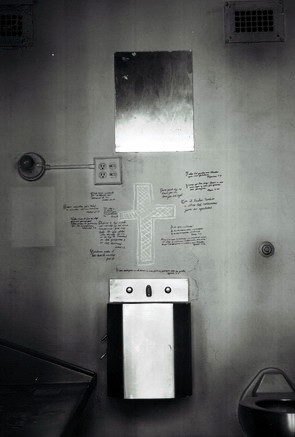 Thus, the selected inmates, in cooperation with their fellow prisoners, made sure that order was maintained and no one jeopardized their good thing. However, by the late 1970’s, the New Mexican correctional system was in disarray. The chain of command among prison officials was weak and confusing and oversight of regulations lax. Around this time prisoner-led programs ended and a new policy was implemented, one whereby prisoners were routinely turned against other prisoners and coercion was used to obtain information and overall compliance. Divide and conquer became the guiding objective. (Accompanying photo shows cell graffiti. Regulations forbidding graffiti were relaxed just before the penitentiary closed.)
Thus, the selected inmates, in cooperation with their fellow prisoners, made sure that order was maintained and no one jeopardized their good thing. However, by the late 1970’s, the New Mexican correctional system was in disarray. The chain of command among prison officials was weak and confusing and oversight of regulations lax. Around this time prisoner-led programs ended and a new policy was implemented, one whereby prisoners were routinely turned against other prisoners and coercion was used to obtain information and overall compliance. Divide and conquer became the guiding objective. (Accompanying photo shows cell graffiti. Regulations forbidding graffiti were relaxed just before the penitentiary closed.)Further, the New Mexico State Penitentiary contained high-security cells, New Mexico’s death row and its attendant gas chamber, as well as the protective custody unit, in which those inmates considered at risk of assault if allowed in the general population were housed.
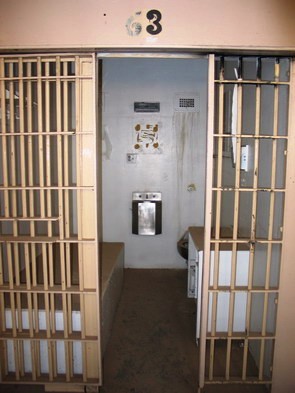 This included prisoners who had given evidence against their fellow inmates. Moreover, when built in 1956, the prison was designed to contain 800 men. By 1980 more than 1100 prisoners lived together in close quarters. A renovation of a cellblock at the time saw some of the most dangerous criminals moved from a high-security area to more dormitory-like arrangements. This overcrowding and mixing of New Mexico’s most violent, notorious, disturbed and vulnerable criminals in one facility was more fuel to be tossed on what was already becoming a dangerous powder keg. (Accompanying photo is of a death row cell. Photo below is of a meeting table beside death row.)
This included prisoners who had given evidence against their fellow inmates. Moreover, when built in 1956, the prison was designed to contain 800 men. By 1980 more than 1100 prisoners lived together in close quarters. A renovation of a cellblock at the time saw some of the most dangerous criminals moved from a high-security area to more dormitory-like arrangements. This overcrowding and mixing of New Mexico’s most violent, notorious, disturbed and vulnerable criminals in one facility was more fuel to be tossed on what was already becoming a dangerous powder keg. (Accompanying photo is of a death row cell. Photo below is of a meeting table beside death row.)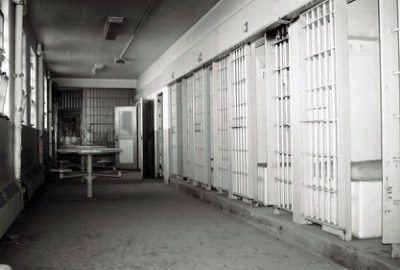
Finally, those guarding the inmates at the penitentiary had grown demoralized and careless. In any given year, 80% of the prison staff quit. The high-turnover rate meant that guards were frequently unfamiliar with the operation of the prison and the building itself. Nor would the guards always know the history of those incarcerated in the prison. At the time of the riot, many guards let prisoners do as they pleased in their cells, as long as it didn’t turn into something the guards had to deal with personally. Thus many prisoners were routinely victims of physical and sexual assault and drug use was rampant. In addition to drugs, some prisoners made their own alcohol, a strange fact which ended up being the flame which finally lit the fuse.
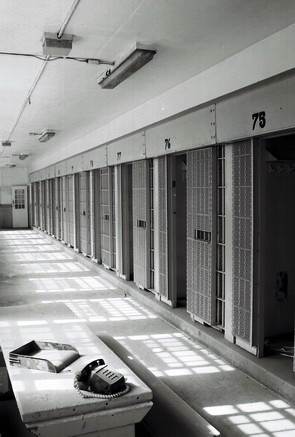 While on their rounds during the early morning of February 2, two guards came upon a couple of prisoners in a dormitory that were drunk on alcohol they’d made with fermented fruit. The intoxicated inmates attacked and overcame the guards and, as the guards had failed to follow procedure, leaving the cell block doors they had just come through open, the prisoners quickly made their way to the prison’s control center, where they flipped switches unlocking most of the penitentiary. Once free, hundreds of inmates fanned throughout the prison, taking fourteen guards and one medical technician hostage. While things were about to get much, much worse, some inmates were already fighting the tide and three guards were given safe hiding places by sympathetic prisoners. Meanwhile, anything that could be used as a weapon was procured and made into one, and the hospital was raided for its drug supply. Even glue was sought out and huffed. (Accompanying photo and photo below are pretty self-explanatory.)
While on their rounds during the early morning of February 2, two guards came upon a couple of prisoners in a dormitory that were drunk on alcohol they’d made with fermented fruit. The intoxicated inmates attacked and overcame the guards and, as the guards had failed to follow procedure, leaving the cell block doors they had just come through open, the prisoners quickly made their way to the prison’s control center, where they flipped switches unlocking most of the penitentiary. Once free, hundreds of inmates fanned throughout the prison, taking fourteen guards and one medical technician hostage. While things were about to get much, much worse, some inmates were already fighting the tide and three guards were given safe hiding places by sympathetic prisoners. Meanwhile, anything that could be used as a weapon was procured and made into one, and the hospital was raided for its drug supply. Even glue was sought out and huffed. (Accompanying photo and photo below are pretty self-explanatory.)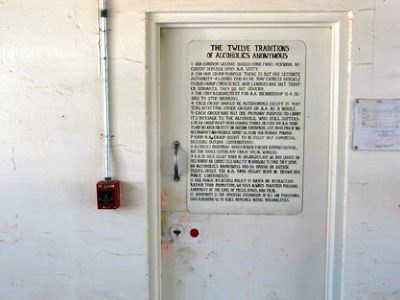
It was about this time that some inmates, possibly less than a dozen, set out for the protective custody unit. Once there, suspected informers were taken from their cells and set on fire or had their limbs cut off one-by-one, each successive wound cauterized to prolong the suffering. One prisoner was propped in front of a window and, in full view of the National Guard, now gathered beyond the 12-foot fence outside, was killed with a blowtorch. While keys to the outside doors of several wings of the prison were available, the decision was made not to enter and, instead, to attempt to negotiate with the prisoners. Meanwhile, the carnage inside escalated.
During the negotiations it became clear that, in fact, no one was in charge of the riot and, therefore, no one was in a position to stop it. Those convicts being negotiated with made claims of overcrowding, bad food and harassment while others, weary of the violence, began to leave the prison and line up along the outside fence, seeking refuge.
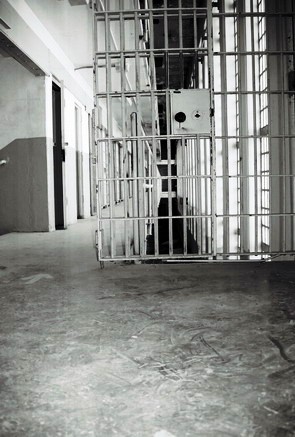 Other prisoners tried to protect certain of their fellow inmates and lost their lives because of it. Still others worked to release the guards. Such was the disarray and lack of leadership that prisoners could release hostages while their fellow inmates made demands intended to be met before these very same hostages would be released. (Accompanying photo is from Cell Block 4, where prisoners in protective custody were housed. The slender white marks on the floor in the foreground were caused by hatchets used to dismember inmates.)
Other prisoners tried to protect certain of their fellow inmates and lost their lives because of it. Still others worked to release the guards. Such was the disarray and lack of leadership that prisoners could release hostages while their fellow inmates made demands intended to be met before these very same hostages would be released. (Accompanying photo is from Cell Block 4, where prisoners in protective custody were housed. The slender white marks on the floor in the foreground were caused by hatchets used to dismember inmates.)By the bitter end, only three hostages remained and two very violent prisoners, Michael Colby and William Jack Stephens, demanded and were granted transfer to a federal facility for their release. Colby and Stephens were told to get their belongings from their cells, the three hostages were released, and the State Police and the National Guard entered the prison and re-took it without opposition from the approximately 100 inmates still inside.
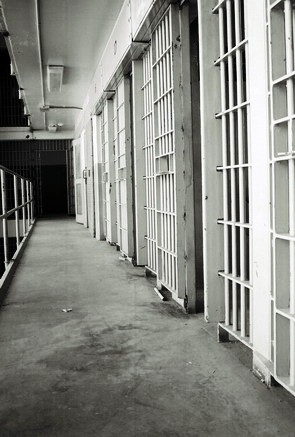 Those entering the prison found true horror: bodies had been put in ovens in the kitchen, limbs were scattered on the ground, one corpse had no head, another was hanging from the ceiling with the word “RAT” cut into its chest, yet another had a metal bar shoved in one ear and out the other. The bodies of two inmates were never found and were presumed entirely incinerated. All told, the 36-hour nightmare left at least 33 inmates dead and nine seriously injured. One guard was in serious condition--some guards were badly beaten and sodomized--and the New Mexican Corrections Department had been brought to its knees. (Accompanying photo is from Cell Block 4. The dark stain on the floor marks where a body was burned.)
Those entering the prison found true horror: bodies had been put in ovens in the kitchen, limbs were scattered on the ground, one corpse had no head, another was hanging from the ceiling with the word “RAT” cut into its chest, yet another had a metal bar shoved in one ear and out the other. The bodies of two inmates were never found and were presumed entirely incinerated. All told, the 36-hour nightmare left at least 33 inmates dead and nine seriously injured. One guard was in serious condition--some guards were badly beaten and sodomized--and the New Mexican Corrections Department had been brought to its knees. (Accompanying photo is from Cell Block 4. The dark stain on the floor marks where a body was burned.)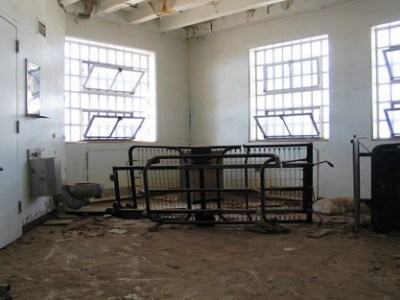
(Above photo shows an old bed frame in the infirmary.)
The major causes of the riot are out-lined above, all of them preventable. Lawsuits had already been filed regarding the overcrowding, the lack of a command structure within the NM prison system was well-known (basic security inspections at the penitentiary went undone for years as no one knew who should be conducting them) and the use of drugs amongst inmates was no secret. Thus the riot itself should have come as no surprise. What is surprising, of course, is the level of violence. Obviously, housing the protective custody unit, which included “snitches,” in the main facility was a grievous mistake and one subsequently corrected.
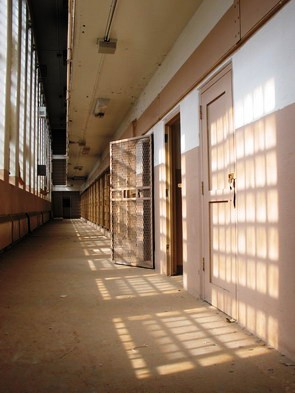 But, beyond that, and in overpowering opposition to those inmates, possibly the vast majority, who did not participate or even risked and lost their lives to reduce the violence, something unspeakably wicked was at work over those 36 hours. James Weston, the Chief Medical Examiner at the time, was quoted as saying, "Virtually every one of the bodies had overkill, which is to say that there was more than mob hysteria. There was rage." That much seems abundantly clear, but the prison psychologist, Dr. Marc Orner, made a much more telling statement when he said, "None of us really understands what happened in there. The depth of the violence is incomprehensible to me as a human being and as a psychologist. It is as if all the aggression a human being can have was savagely unleashed. We just can't understand why they did this to each other." (Accompanying photo shows a few rays of sunlight.)
But, beyond that, and in overpowering opposition to those inmates, possibly the vast majority, who did not participate or even risked and lost their lives to reduce the violence, something unspeakably wicked was at work over those 36 hours. James Weston, the Chief Medical Examiner at the time, was quoted as saying, "Virtually every one of the bodies had overkill, which is to say that there was more than mob hysteria. There was rage." That much seems abundantly clear, but the prison psychologist, Dr. Marc Orner, made a much more telling statement when he said, "None of us really understands what happened in there. The depth of the violence is incomprehensible to me as a human being and as a psychologist. It is as if all the aggression a human being can have was savagely unleashed. We just can't understand why they did this to each other." (Accompanying photo shows a few rays of sunlight.)The American justice system seems a shadowy and powerful animal and the forces it wields are largely beyond our understanding. We know very little about how to alter the human spirit to the good; there are myriad ways to corrupt that same spirit and plunge it into darkness. Can prisons consistently do the former rather than the latter? To what degree does the criminal justice system create monsters that can murder without mercy? Or, to what degree do those monsters arrive fully-formed, merely waiting? The questions are serious, the answers remain unclear. (Photo below is of the check-in desk of the infirmary. The infirmary was raided for drugs during the riot.)
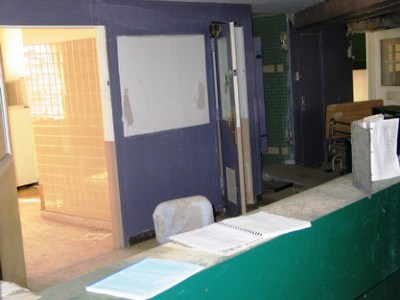
Post-script:
Interestingly enough, apart from the obvious changes to the prison system in the years following the riot, changes in the prison population itself have reduced the likelihood of such riots. Prison gangs have consolidated their power and, where numerous small gangs used to fight for position and influence, now only a couple well-established gangs maintain a fragile peace. Finally, in the mid-1980’s, drug smuggling within the New Mexico State Penitentiary (and, I would imagine, prisons throughout the country), became more sophisticated and materially lucrative. Drugs are now a significant incentive, both to the users and distributors within the prison, and no one wants to rock the boat if it means they might not get their fix. Thus crime controls the criminal.
There have been books published on the riot, such as the Devil's Butcher Shop by Roger Morris and the Hate Factory by Georgelle Hirliman, yet much of what you find on the internet is somewhat basic and very similar. One of the most instructive websites I found included this INTERVIEW with an initial investigator of the event. Also, Time Magazine’s original coverage, published just after the riot, was quite interesting.
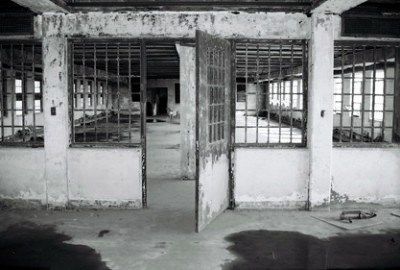
(Above photo is from the second floor of the prison. This may have been a cafeteria.)
9 comments:
buen trabajo...
Great Site!
Muchas gracias, amigos. Nano, Madrid es muy bonita!
Buenas noches,
JM
If Frank Sinatra was there he would have killed all those rioting inmates with his bare fucking hands
Yeah,him and Dean martin
William jack two pack ran shit worked his way to the top I wonder if he is still kicking
Whew idk about today. May have passed. He's featured in Shakedown in Santa Fe (1988), he seemed to be doing good. Kinda rugged. I believe he was in protective custody. They mentioned at the end that an attempt on his life was made. Sucks. You would expect after 8 years they would've banded together stronger. I guess not. Nor did the government put more effort into rehabilitation. Sad stores on both sides. Shame.
My brother was killed in the riot and he knew it was coming before it happened.
He’s dead.
Post a Comment